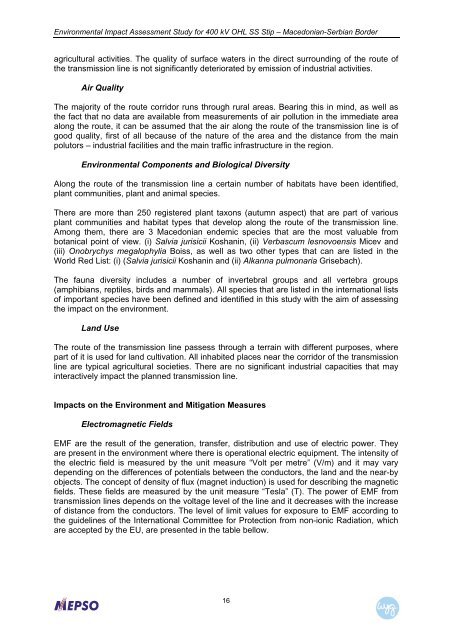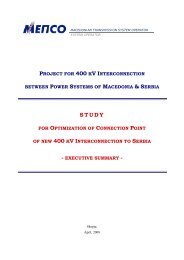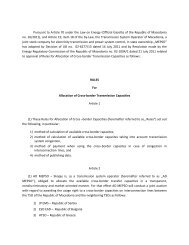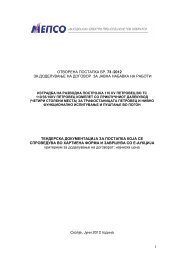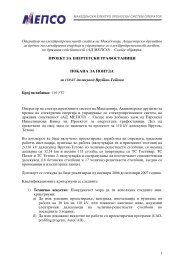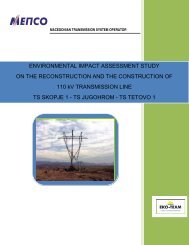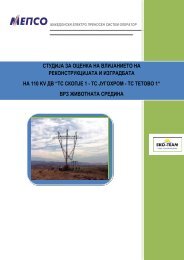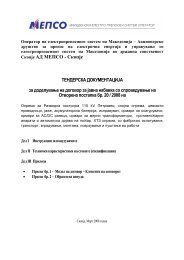Part A - EIA 400 kV OHTL Stp - мепÑо а.д.
Part A - EIA 400 kV OHTL Stp - мепÑо а.д.
Part A - EIA 400 kV OHTL Stp - мепÑо а.д.
You also want an ePaper? Increase the reach of your titles
YUMPU automatically turns print PDFs into web optimized ePapers that Google loves.
Environmental Impact Assessment Study for <strong>400</strong> <strong>kV</strong> OHL SS Stip – Macedonian-Serbian Borderagricultural activities. The quality of surface waters in the direct surrounding of the route ofthe transmission line is not significantly deteriorated by emission of industrial activities.Air QualityThe majority of the route corridor runs through rural areas. Bearing this in mind, as well asthe fact that no data are available from measurements of air pollution in the immediate areaalong the route, it can be assumed that the air along the route of the transmission line is ofgood quality, first of all because of the nature of the area and the distance from the mainpolutors – industrial facilities and the main traffic infrastructure in the region.Environmental Components and Biological DiversityAlong the route of the transmission line a certain number of habitats have been identified,plant communities, plant and animal species.There are more than 250 registered plant taxons (autumn aspect) that are part of variousplant communities and habitat types that develop along the route of the transmission line.Among them, there are 3 Macedonian endemic species that are the most valuable frombotanical point of view. (i) Salvia jurisicii Koshanin, (ii) Verbascum lesnovoensis Micev and(iii) Onobrychys megalophylia Boiss, as well as two other types that can are listed in theWorld Red List: (i) (Salvia jurisicii Koshanin and (ii) Alkanna pulmonaria Grisebach).The fauna diversity includes a number of invertebral groups and all vertebra groups(amphibians, reptiles, birds and mammals). All species that are listed in the international listsof important species have been defined and identified in this study with the aim of assessingthe impact on the environment.Land UseThe route of the transmission line passess through a terrain with different purposes, wherepart of it is used for land cultivation. All inhabited places near the corridor of the transmissionline are typical agricultural societies. There are no significant industrial capacities that mayinteractively impact the planned transmission line.Impacts on the Environment and Mitigation MeasuresElectromagnetic FieldsEMF are the result of the generation, transfer, distribution and use of electric power. Theyare present in the environment where there is operational electric equipment. The intensity ofthe electric field is measured by the unit measure “Volt per metre” (V/m) and it may varydepending on the differences of potentials between the conductors, the land and the near-byobjects. The concept of density of flux (magnet induction) is used for describing the magneticfields. These fields are measured by the unit measure “Tesla” (T). The power of EMF fromtransmission lines depends on the voltage level of the line and it decreases with the increaseof distance from the conductors. The level of limit values for exposure to EMF according tothe guidelines of the International Committee for Protection from non-ionic Radiation, whichare accepted by the EU, are presented in the table bellow.16


